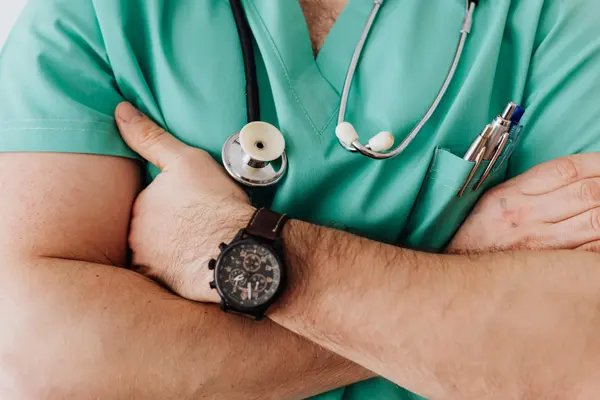Blog

Ending the Opioid Crisis Starts with Physicians - A. Baxter MD
A recently published opinion article by opioid advocates attempts to assuage physicians’ prescribing guilt, arguing “doctors prescribing to their patients did not create the U.S. opioid crisis.” As lawsuit after lawsuit concludes, Purdue Pharma, Johnson and Johnson, and blindered distributors and pharmacies share the blame for propping up pills for profit. Physicians may inflate home narcotic quantities for convenience but with rare prosecutable exceptions, not monetary gain. But the creation of the crisis differs from perpetuation. Continuing to treat post-surgical recovery pain with opioids instead of options keeps the crisis alive.
On average, American medical schools include 12 hours of pain education – mostly on pharmacology. Supplementing lectures in residency called “noon conferences” are sponsored by pharma companies, serving corporate slides with a side of lasagna. Purdue Pharma slides, for example, featured misleading data to support the “home opioids aren’t addictive” messaging: an IN-hospital review letter to the New England Journal of Medicine editor, not a prospective OUTpatient study. Nested in the oxycontin marketing ingested by physicians in the ’90s was equally inaccurate and deleterious framing, of pain-free as the goal, and pills as the path to pain eradication.
Pain is an organism’s primary safety system, the brain’s best guess of your safety. Through functional MRI mapping, we now know that pain connections between memory, fear, identity, coping styles, and sensation that reach the brain differ for different people. We also know that opioids don’t operate on pain sensation areas, but instead activate the brain’s reward system. The reward system initially overrides pain’s safety warnings, so pain is felt but not distressing. For intense pain from surgery, burns, or battlefield injuries, the amount of morphine in the first 24 hours seems protective against PTSD and chronic pain in adults and children. A recently discovered time-sensitive receptor may explain why opioid rewards are effective for early or intense pain perception, but lose luster later. Home opioids, from oral surgery to casted fractures and low back pain, have more risk than benefit.
Multiple things can be true. Unquestionably, opioid use disorder relates to socioeconomic disparity. Despair, fear, and lack of attachment can lead to reward-seeking. Opioid mu receptor signaling is a powerful activator of the dopamine system. When stressors are removed, reward-seeking from substances goes down. Undeniably, people on a steady opioid dose for chronic pain can be maintained without issues and were done a deep disservice by prescribing scrutiny. Increased fear and helplessness increase pain, and our healthcare system fails to offer education or alternatives.
And 80 percent of opioid use disorder starts with pills prescribed for pain. Similarly, 78 percent of the initially misused opioids are obtained for free from friends' and family’s medicine cabinets, often without their knowledge. These pills were prescribed in excess by physicians and oral surgeons, then kept “just in case.” Opioid restriction gave narcotics “the good stuff” status, too good to discard. Few patients in opioid-sparing trials of outpatient surgery actually took more than five pills; prescribing double-digit quantities of opioids unnecessarily perpetuates the crisis, extending it to bystanders.
Even opioids used as and by the intended patient carry risk, beginning after three days of outpatient use. OUD incidence is well described after different surgeries, from C-sections to total knee replacement. Contextual risk factors associated with post-op OUD include prior use to depression to family history. However, a study published in 2019 by Schroeder et al. found that 6.4 percent of young adults prescribed opioids for wisdom tooth removal had opioid use disorder after one year compared to 0.6 percent of those who weren’t prescribed opioids. No antecedent use. Minor surgery. One in 15.
Some OUD risks may be due to genetic metabolism. About 15 percent of people metabolize opioids so quickly, they get a rush of euphoria beyond not caring about the pain. This reward stimulus then wears off quickly, so they notice pain again too soon to take another pill. One study from 2008 found the euphoria with a first opioid exposure correlated with an 18-fold risk of OUD compared to maintenance opioid use in people who didn’t recall feeling elated with their first opioid experience.
The irony is that for most outpatient pain management, ibuprofen works better than opioids, with fewer side effects. This changes the risk/benefit in prescribing, from fractures to wisdom teeth to outpatient surgeries. Coaching, magnesium, activity, physical devices, and brain-body interventions can obviate the use of adding opioids to OTC options. The issue that they’re neither taught to physicians nor covered by Medicare is a different discussion.
It is true that opioids in the hospital are beneficial and carry little risk. It is true that many people with chronic pain can benefit from stable opioid doses without escalation. It is also true that home opioids are often unnecessary or prescribed in excess, with quantified but unpredictable life-threatening risks. Physicians didn’t cause the opioid crisis, but we can do much more to end it.